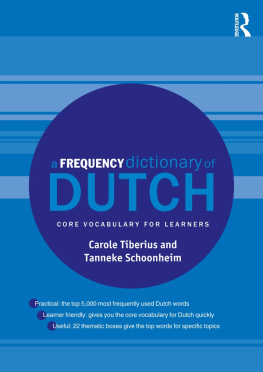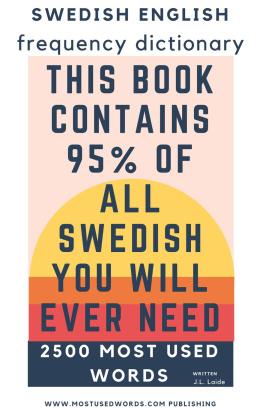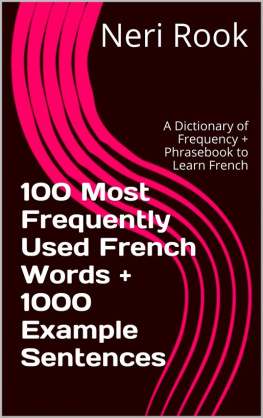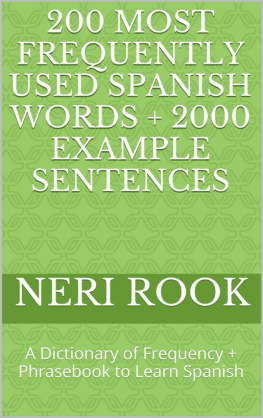Tanneke Schoonheim - A Frequency Dictionary of Dutch
Here you can read online Tanneke Schoonheim - A Frequency Dictionary of Dutch full text of the book (entire story) in english for free. Download pdf and epub, get meaning, cover and reviews about this ebook. year: 2013, publisher: Routledge, genre: Science / History. Description of the work, (preface) as well as reviews are available. Best literature library LitArk.com created for fans of good reading and offers a wide selection of genres:
Romance novel
Science fiction
Adventure
Detective
Science
History
Home and family
Prose
Art
Politics
Computer
Non-fiction
Religion
Business
Children
Humor
Choose a favorite category and find really read worthwhile books. Enjoy immersion in the world of imagination, feel the emotions of the characters or learn something new for yourself, make an fascinating discovery.
- Book:A Frequency Dictionary of Dutch
- Author:
- Publisher:Routledge
- Genre:
- Year:2013
- Rating:5 / 5
- Favourites:Add to favourites
- Your mark:
- 100
- 1
- 2
- 3
- 4
- 5
A Frequency Dictionary of Dutch: summary, description and annotation
We offer to read an annotation, description, summary or preface (depends on what the author of the book "A Frequency Dictionary of Dutch" wrote himself). If you haven't found the necessary information about the book — write in the comments, we will try to find it.
A Frequency Dictionary of Dutch — read online for free the complete book (whole text) full work
Below is the text of the book, divided by pages. System saving the place of the last page read, allows you to conveniently read the book "A Frequency Dictionary of Dutch" online for free, without having to search again every time where you left off. Put a bookmark, and you can go to the page where you finished reading at any time.
Font size:
Interval:
Bookmark:
A Frequency Dictionary of Dutch A Frequency Dictionary of Dutch is a valuable tool for all learners of Dutch, providing a list of the 5,000 most frequently used words in the language. Based on a 290-million-word corpus which includes both written and spoken material from a wide range of sources, this dictionary presents Dutch core vocabulary in a detailed and clearly arranged manner: each of the 5,000 entries includes English equivalents and a sample sentence showing language in use. Users can access the top 5,000 words through either the main frequency listings or an alphabetical index. Throughout the frequency listings there are thematically organized lists featuring the top words from a variety of key topics such as animals, food and other areas of daily and cultural life. Words specific to Dutch in Belgium (Belgian Dutch) are also included. An engaging and efficient resource, A Frequency Dictionary of Dutch will enable students of all levels to get the most out of their study.
This book was prepared in association with the Instituut voor Nederlandse Lexicologie (INL, Institute of Dutch Lexicology). A CD version is available to purchase separately. Designed for use by corpus and computational linguists, it provides the full text in a format that researchers can process and turn into suitable lists for their own research purposes. Carole Tiberius is a computational linguist at the INL (Institute of Dutch Lexicology). Tanneke Schoonheim is a linguist and lexicographer at the INL (Institute of Dutch Lexicology). Routledge Frequency DictionariesGeneral Editors Paul Rayson, Lancaster University, UK Mark Davies, Brigham Young University, USAEditorial Board Michael Barlow, University of Auckland, New Zealand Geoffrey Leech, Lancaster University, UK Barbara Lewandowska-Tomaszczyk, University of Lodz, Poland Josef Schmied, Chemnitz University of Technology, Germany Andrew Wilson, Lancaster University, UK Adam Kilgarriff Lexicography MasterClass Ltd and University of Sussex, UK Hongying Tao, University of California at Los Angeles Chris Tribble, Kings College London, UKOther books in the series A Frequency Dictionary of Arabic A Frequency Dictionary of Contemporary American English A Frequency Dictionary of Czech A Frequency Dictionary of French A Frequency Dictionary of German A Frequency Dictionary of Japanese A Frequency Dictionary of Mandarin Chinese A Frequency Dictionary of Portuguese A Frequency Dictionary of Russian A Frequency Dictionary of Spanish A Frequency Dictionary of Dutch Core vocabulary for learnersCarole Tiberius and Tanneke Schoonheim First published 2014 by Routledge 2 Park Square, Milton Park, Abingdon, Oxon OX14 4RN and by Routledge 711 Third Avenue, New York, NY 10017 Routledge is an imprint of the Taylor & Francis Group, an informa business 2014 Carole Tiberius and Tanneke Schoonheim of INL The right of Carole Tiberius and Tanneke Schoonheim, both of INL, to be identified as authors of this work has been asserted by them in accordance with sections 77 and 78 of the Copyright, Designs and Patents Act 1988.
First published 2014 by Routledge 2 Park Square, Milton Park, Abingdon, Oxon OX14 4RN and by Routledge 711 Third Avenue, New York, NY 10017 Routledge is an imprint of the Taylor & Francis Group, an informa business 2014 Carole Tiberius and Tanneke Schoonheim of INL The right of Carole Tiberius and Tanneke Schoonheim, both of INL, to be identified as authors of this work has been asserted by them in accordance with sections 77 and 78 of the Copyright, Designs and Patents Act 1988.
All rights reserved. No part of this book may be reprinted or reproduced or utilised in any form or by any electronic, mechanical, or other means, now known or hereafter invented, including photocopying and recording, or in any information storage or retrieval system, without permission in writing from the publishers. Trademark notice: Product or corporate names may be trademarks or registered trademarks, and are used only for identification and explanation without intent to infringe. British Library Cataloguing in Publication Data A catalogue record for this book is available from the British Library Library of Congress Cataloging in Publication Data Tiberius, Carole. A frequency dictionary of Dutch : core vocabulary for learners / Carole Tiberius and Tanneke Schoonheim. pages cm.
Includes bibliographical references and index. 1. English languageDictionariesDutch. 2. Dutch languageDictionariesEnglish. 3.
Dutch languageSpoken Dutch. I. Schoonheim, Tanneke. II. Title. PF640.T53 2014 439.31321dc23 2013024187 ISBN: 978-0-415-52379-0 (hbk) ISBN: 978-0-415-52380-6 (pbk) ISBN: 978-1-315-85748-0 (ebk) ISBN: 978-0-415-82051-6 (CD) 
 Frequency information has a central role to play in learning a language.
Frequency information has a central role to play in learning a language.
Nation (1990) showed that the 4,0005,000 most frequent words account for up to 95% of a written text and the 1,000 most frequent words account for 85% of speech. Although Nations results were only for English, they do provide clear evidence that, when employing frequency as a general guide for vocabulary learning, it is possible to acquire a lexicon which will serve a learner well most of the time. There are two caveats to bear in mind here. First, counting words is not as straightforward as it might seem. Gardner (2007) highlights the problems that multiple word meanings, the presence of multiword items, and grouping words into families or lemmas, have on counting and analysing words. Second, frequency data contained in frequency dictionaries should never act as the only information source to guide a learner.
Frequency information is nonetheless a very good starting point, and one which may produce rapid benefits. It therefore seems rational to prioritize learning the words that you are likely to hear and read most often. That is the philosophy behind this series of dictionaries. Lists of words and their frequencies have long been available for teachers and learners of language. For example, Thorndike (1921, 1932) and Thorndike and Lorge (1944) produced word-frequency books with counts of word occurrences in texts used in the education of American children. Michael Wests General Service List of English Words (1953) was primarily aimed at foreign learners of English.
More recently, with the aid of efficient computer software and very large bodies of language data (called corpora), researchers have been able to provide more sophisticated frequency counts from both written text and transcribed speech. One important feature of the resulting frequencies presented in this series is that they are derived from recently collected language data. The earlier lists for English included samples from, for example, Austens Pride and Prejudice and Defoes Robinson Crusoe, thus they could no longer represent present-day language in any sense. Frequency data derived from a large representative corpus of a language brings students closer to language as it is used in real life as opposed to textbook language (which often distorts the frequencies of features in a language, see Ljung, 1990). The information in these dictionaries is presented in a number of formats to allow users to access the data in different ways. So, for example, if you would prefer not to simply drill down through the word frequency list, but would rather focus on verbs for example, the part of speech index will allow you to focus on just the most frequent verbs.
Given that verbs typically account for 20% of all words in a language, this may be a good strategy. Also, a focus on function words may be equally rewarding 60% of speech in English is composed of a mere 50 function words. The series also provides information of use to the language teacher. The idea that frequency information may have a role to play in syllabus design is not new (see, for example, Sinclair and Renouf 1988). However, to date it has been difficult for those teaching languages other than English to use frequency information in syllabus design because of a lack of data. Frequency information should not be studied to the exclusion of other contextual and situational knowledge about language use and we may even doubt the validity of frequency information derived from large corpora.
Next pageFont size:
Interval:
Bookmark:
Similar books «A Frequency Dictionary of Dutch»
Look at similar books to A Frequency Dictionary of Dutch. We have selected literature similar in name and meaning in the hope of providing readers with more options to find new, interesting, not yet read works.
Discussion, reviews of the book A Frequency Dictionary of Dutch and just readers' own opinions. Leave your comments, write what you think about the work, its meaning or the main characters. Specify what exactly you liked and what you didn't like, and why you think so.












